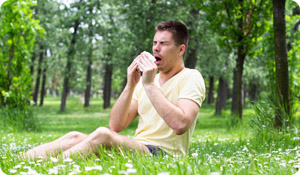
If the warm weather means sneezing and watery eyes, you may want to pay attention to the pollen counts on news and weather reports. That’s because there’s a very good chance that your allergic symptoms are directly related to the pollen in the air.
What is Pollen?
Pollen is a fine powder given off by plants, trees, and grasses, and it travels through the air to fertilize similar plants so they can reproduce. The kind of pollen that causes the most trouble for humans comes from plants like ragweed, tumbleweed, and some varieties of trees. This pollen is carried from plant to plant and tree to tree by the wind, as opposed to pollen from brightly colored flowers and scented plants, which is transported by bees. This airborne pollen is the primary cause of all the sneezing, coughing, and nose blowing you do during the warmer months.
Measuring Pollen
Environmental and health departments typically use a special device that collects pollen grains over a 24-hour period. The results are transmitted to local weather forecasters as well as health professionals. The more grains of pollen that appear on the device, the higher the pollen count is. You aren’t necessarily getting exact “real-time” pollen counts from a forecast, but the number can give you a good indication of what’s (literally) floating around in the air.
While you can’t prevent pollen from traveling (nor would you want to, if you enjoy flora and foliage), there are things you can do to make your symptoms more bearable:
- First, talk with your allergist about taking a daily dose of allergy medication to get you through the season.
- Next, listen to the weather report every morning to get an idea of how troublesome your symptoms are likely to be that day. If pollen counts are low, you may be able to go outside without experiencing any discomfort. If the counts are high, however, you may want to curtail your time outside. These are the days when you should consider exercising on a machine rather than going for a walk or a run, or at least limiting your outdoor activities to times other than early morning, when pollen counts typically are at their highest. Try to avoid being out on dry, breezy days, which make it easier for pollen to travel, and aim for chillier, damper ones.
- To make your indoor environment more comfortable on high-pollen days, keep your windows shut and set your air conditioner so that it recirculates the air already inside your house rather than pulling in air from the outside. And don’t forget to do the same when you’re in your car.
Reviewed by Jonathan Parsons, MD, associate director of The Ohio State University Asthma Center.
Sources
"Pollen and Mold Counts." Asthma and Allergy Foundation of America. Accessed March 31, 2014.





